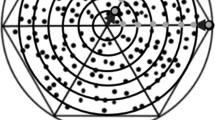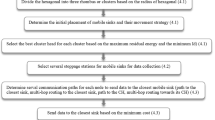Abstract
In recent years, wireless sensor networks experience the energy hole problem as the most critical issue due to the heavy data forwarding load on the proximate sensor nodes to the sink. The best known solution found by the current state-of-the-art approaches for the energy hole problem is the Mobile Sink (MS) strategy. However, allowing the MS to visit every node for data collection incurs high data delivery latency, which may not be feasible in delay-sensitive applications. Thus, in this paper, restricted mobile sink motion is considered, where the MS halts at a limited number of locations stated as sojourn locations and all nodes disseminate their data to the nearby sojourn locations. The data dissemination to the sojourn location is achieved via a cluster-based routing protocol which aims to preserve the sensor nodes’ energy to enhance the network lifetime. Furthermore, analogous to network lifetime, extending the coverage lifetime is of equal importance in many coverage sensitive applications of WSN. Thus, this article incorporates the coverage parameter to the proposed protocol in order to preserve the network coverage despite certain nodes die. Based on the sojourn locations, the proposed routing algorithm ensures that each cluster data is disseminated to the MS following the minimum hop path to limit the data delivery delay. Experimental results demonstrate the efficacy of the proposed protocol over several state-of-the-art protocols with respect to different metrics like network lifetime, coverage ratio, energy efficiency, packet delivery ratio, end-to-end delay, etc.
















Similar content being viewed by others
References
Abdul-Salaam G, Abdullah AH, Anisi MH, Gani A, Alelaiwi A (2016) A comparative analysis of energy conservation approaches in hybrid wireless sensor networks data collection protocols. Telecommun Syst 61(1):159–179
Abo-Zahhad M, Ahmed SM, Sabor N, Sasaki S (2015) Mobile sink-based adaptive immune energy-efficient clustering protocol for improving the lifetime and stability period of wireless sensor networks. IEEE Sens J 15(8):4576–4586
Alaei M, Yazdanpanah F (2019) Eelcm: an energy efficient load-based clustering method for wireless mobile sensor networks. Mob Netw Appl 24(5):1486–1498
Anisi MH, Rezazadeh J, Dehghan M (2008) Feda: fault-tolerant energy-efficient data aggregation in wireless sensor networks. In: 2008 16th international conference on software, telecommunications and computer networks, IEEE, pp 188–192
Anisi MH, Abdullah AH, Razak SA (2012) Efficient data gathering in mobile wireless sensor networks. Life Sci J 9(4):2152–2157
Anisi MH, Abdullah AH, Razak SA (2013) Energy-efficient and reliable data delivery in wireless sensor networks. Wirel Netw 19(4):495–505
Benzaïd C, Bagaa M, Younis M (2017) Efficient clock synchronization for clustered wireless sensor networks. Ad Hoc Netw 56:13–27
Bhatia M, Sood SK (2018) Internet of things based activity surveillance of defence personnel. J Ambient Intell Humaniz Comput 9(6):2061–2076
Bozorgi SM, Bidgoli AM (2019) Heec: a hybrid unequal energy efficient clustering for wireless sensor networks. Wirel Netw 25(8):4751–4772
Chen DR, Chen LC, Chen MY, Hsu MY (2019) A coverage-aware and energy-efficient protocol for the distributed wireless sensor networks. Comput Commun 137:15–31
Christopher VB, Jasper J (2020) Dhgrp: dynamic hexagonal grid routing protocol with mobile sink for congestion control in wireless sensor networks. Wirel Pers Commun 112:1–20
Deebak B, Al-Turjman F (2020) A hybrid secure routing and monitoring mechanism in IOT-based wireless sensor networks. Ad Hoc Netw 97:102022
Elkamel R, Messouadi A, Cherif A (2019) Extending the lifetime of wireless sensor networks through mitigating the hot spot problem. J Parallel Distrib Comput 133:159–169
Farsi M, Elhosseini MA, Badawy M, Ali HA, Eldin HZ (2019) Deployment techniques in wireless sensor networks, coverage and connectivity: a survey. IEEE Access 7:28940–28954
Fotohi R, Bari SF (2020) A novel countermeasure technique to protect wsn against denial-of-sleep attacks using firefly and hopfield neural network (HNN) algorithms. J Supercomput. https://doi.org/10.1007/s11227-019-03131-x
Fotohi R, Firoozi Bari S, Yusefi M (2020) Securing wireless sensor networks against denial-of-sleep attacks using RSA cryptography algorithm and interlock protocol. Int J Commun Syst 33(4):e4234
Glaroudis D, Iossifides A, Chatzimisios P (2020) Survey, comparison and research challenges of iot application protocols for smart farming. Comput Netw 168:107037
Gu X, Yu J, Yu D, Wang G, Lv Y (2014) Ecdc: an energy and coverage-aware distributed clustering protocol for wireless sensor networks. Comput Electr Eng 40(2):384–398
Gumaida BF, Luo J (2019) Novel localization algorithm for wireless sensor network based on intelligent water drops. Wirel Netw 25(2):597–609
Heinzelman WR, Chandrakasan A, Balakrishnan H (2000) Energy-efficient communication protocol for wireless microsensor networks. In: Proceedings of the 33rd annual Hawaii international conference on system sciences, IEEE, p 10
Jamali S, Fotohi R (2016) Defending against wormhole attack in manet using an artificial immune system. New Rev Inf Netw 21(2):79–100
Jamali S, Fotohi R (2017) Dawa: defending against wormhole attack in manets by using fuzzy logic and artificial immune system. J Supercomput 73(12):5173–5196
Krishnan M, Yun S, Jung YM (2019) Dynamic clustering approach with ACO-based mobile sink for data collection in WSNS. Wirel Netw 25(8):4859–4871
Mabodi K, Yusefi M, Zandiyan S, Irankhah L, Fotohi R (2020) Multi-level trust-based intelligence schema for securing of internet of things (IOT) against security threats using cryptographic authentication. J Supercomput. https://doi.org/10.1007/s11227-019-03137-5
Mazumdar N, Om H (2017) Distributed fuzzy logic based energy-aware and coverage preserving unequal clustering algorithm for wireless sensor networks. Int J Commun Syst 30(13):e3283
Mazumdar N, Om H (2018) Distributed fuzzy approach to unequal clustering and routing algorithm for wireless sensor networks. Int J Commun Syst 31(12):e3709
Mehto A, Tapaswi S, Pattanaik K (2020) Virtual grid-based rendezvous point and sojourn location selection for energy and delay efficient data acquisition in wireless sensor networks with mobile sink. Wirel Netw 26:1–17
Mittal N, Srivastava R (2020) An energy efficient clustered routing protocols for wireless sensor networks. In: Recent trends and advances in artificial intelligence and internet of things. Springer, New York, pp 581–596
Mottaghi S, Zahabi MR (2015) Optimizing leach clustering algorithm with mobile sink and rendezvous nodes. AEU Int J Electron Commun 69(2):507–514
Ramos HS, Boukerche A, Oliveira AL, Frery AC, Oliveira EM, Loureiro AA (2016) On the deployment of large-scale wireless sensor networks considering the energy hole problem. Comput Netw 110:154–167
Rashid B, Rehmani MH (2016) Applications of wireless sensor networks for urban areas: a survey. J Netw Comput Appl 60:192–219
Ren J, Zhang Y, Zhang K, Liu A, Chen J, Shen XS (2016) Lifetime and energy hole evolution analysis in data-gathering wireless sensor networks. IEEE Trans Ind Inform 12(2):788–800
Seyedi B, Fotohi R (2020) Niashpt: a novel intelligent agent-based strategy using hello packet table (HPT) function for trust internet of things. J Supercomput. https://doi.org/10.1007/s11227-019-03143-7
Sharma S, Puthal D, Jena SK, Zomaya AY, Ranjan R (2017) Rendezvous based routing protocol for wireless sensor networks with mobile sink. J Supercomput 73(3):1168–1188
Sharma V, Patel R, Bhadauria H, Prasad D (2016) Deployment schemes in wireless sensor network to achieve blanket coverage in large-scale open area: a review. Egypt Inform J 17(1):45–56
Soro S, Heinzelman WB (2009) Cluster head election techniques for coverage preservation in wireless sensor networks. Ad Hoc Netw 7(5):955–972
Sundhari RM, Jaikumar K (2020) Iot assisted hierarchical computation strategic making (HCSM) and dynamic stochastic optimization technique (DSOT) for energy optimization in wireless sensor networks for smart city monitoring. Comput Commun 150:226–234
Ullah Z (2020) A survey on hybrid, energy efficient and distributed (heed) based energy efficient clustering protocols for wireless sensor networks. Wirel Pers Commun 112:1–29
Vijayalakshmi V, Senthilkumar A (2019) Uscdrp: unequal secure cluster-based distributed routing protocol for wireless sensor networks. J Supercomput 76:1–16
Wang J, Cao J, Sherratt RS, Park JH (2017) An improved ant colony optimization-based approach with mobile sink for wireless sensor networks. J Supercomput 74:1–13
Wang J, Gao Y, Yin X, Li F, Kim HJ (2018a) An enhanced pegasis algorithm with mobile sink support for wireless sensor networks. Wirel Commun Mob Comput. https://doi.org/10.1155/2018/9472075
Wang Z, Zhang B, Wang X, Jin X, Bai Y (2018b) Improvements of multihop localization algorithm for wireless sensor networks. IEEE Syst J 99:1–12
Yarinezhad R (2019) Reducing delay and prolonging the lifetime of wireless sensor network using efficient routing protocol based on mobile sink and virtual infrastructure. Ad Hoc Netw 84:42–55
Yarinezhad R, Hashemi SN (2018) A cellular data dissemination model for wireless sensor networks. Pervasive Mob Comput 48:118–136
Yarinezhad R, Hashemi SN (2019) An efficient data dissemination model for wireless sensor networks. Wirel Netw 25(6):3419–3439
Yue YG, He P (2018) A comprehensive survey on the reliability of mobile wireless sensor networks: taxonomy, challenges, and future directions. Inf Fusion 44:188–204
Author information
Authors and Affiliations
Corresponding author
Additional information
Publisher's Note
Springer Nature remains neutral with regard to jurisdictional claims in published maps and institutional affiliations.
Rights and permissions
About this article
Cite this article
Roy, S., Mazumdar, N. & Pamula, R. An energy and coverage sensitive approach to hierarchical data collection for mobile sink based wireless sensor networks. J Ambient Intell Human Comput 12, 1267–1291 (2021). https://doi.org/10.1007/s12652-020-02176-8
Received:
Accepted:
Published:
Issue Date:
DOI: https://doi.org/10.1007/s12652-020-02176-8




